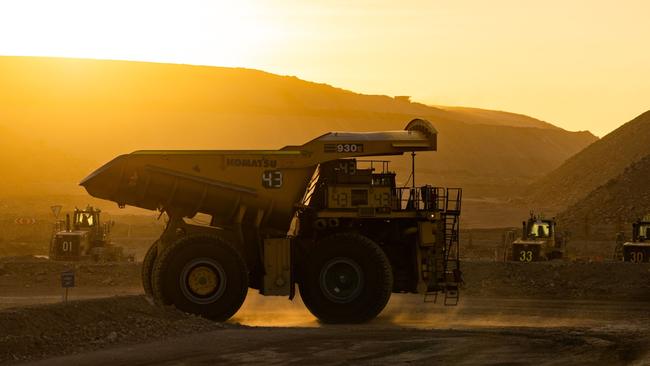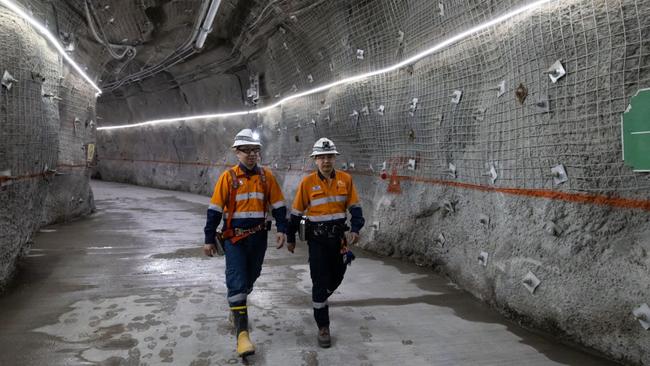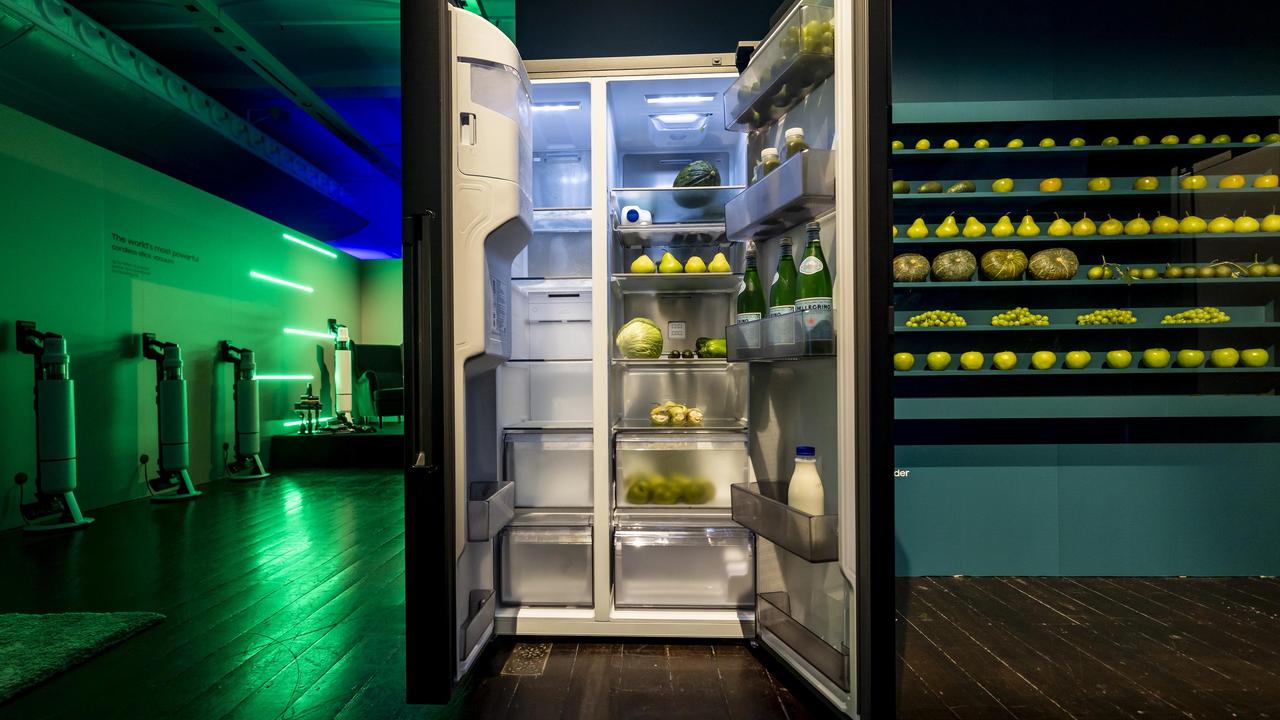
To do that the chief executive has set aside $US20bn ($29.6bn) over the next two years, and much of this will be spent on new projects including the massive greenfields Simandou iron ore project in Guinea, as well as building out his copper mines in southern Mongolia and the US. The big unknown is how much will be spent on greening Australian aluminium operations.
All of the spending is with the aim of turning Rio Tinto into a company that does more than rise and fall on commodity prices. The ambition comes after almost a decade where the absolute volume of commodities Rio produces has remained largely flat with the miner spending a lot of money just to stand still.

But with operational improvements in iron ore, as well as the ramp-up of its new Gudai-Darri mine in the Pilbara that opened last year, and the giant Mongolian mine coming on-stream, Rio Tinto is starting to move the dial on output.
“I do think we’ve got to be realistic, we’re never going to be a high-growth company,” says Stausholm, speaking to The Australian from London.
“The point is we are facing markets where demand is growing between three and four per cent in the next decade in terms of copper, aluminium and demand for battery materials. So when we are one of the world’s largest miners, why shouldn’t we grow?”
Stausholm’s first path to get there is to drive more from Rio’s existing operations. And the second is to keep adding to his portfolio that also extends to lithium as well as energy-intensive aluminium.
The $US10bn spend over each of the next two years is a substantial step up from the pre-Covid period when Rio was averaging a capex bill of $US4.5bn a year. The future spending commitment will also cover the replacement of the ageing aluminium smelter in Canada. It also includes spending on projects designed to slash carbon emissions from its operations – including aluminium smelting.
Green problems
Right now though, Stausholm has bigger problems in Australia. And this has serious implications for the nation’s industrial future.
Stausholm is struggling to secure enough renewable energy to power Rio’s aluminium smelters in Gladstone and outside Newcastle. Combined, the two operations represent half of his local carbon output and are undermining his push to slash emissions by the end of the decade.
But it was the Albanese government’s centrepiece climate bill passed in March forcing big emitters to slash emissions over the coming decade that has put a large shadow over the future of the two operations.
Essentially the problem comes down to Rio finding enough reliable – and cheap – green energy to power what ranks as Australia’s biggest electricity users. And Stausholm is running out of time to make a call on his future investment here.
Indeed, Energy Minister Chris Bowen’s safeguard bill has now forced Rio to make a $US1.17bn pre-tax write down, leaving the operations worth just a third of their book value. Rio’s other smelters in Canada and New Zealand are in a better position given they are underpinned by hydro power.

With the plants now fetching a deep discount, Stausholm hasn’t ruled out a sale of the Australian assets, but he “feels a big responsibility to explore all opportunities to future proof” the aluminium business here.
“Yes – we didn’t make any money (from them) in the first half, it was a difficult one. It’s more about how you make them competitive for the next two decades,” he says.
“We have to find the solution and I’m determined to do everything I can. But ultimately, if we can’t get renewables it’s impossible to produce something and export it out of Australia.”
Stausholm was talking as Rio’s first-half underlying earnings of $US5.7bn were down from $8.7bn from the same time a year ago, although that was largely on a pullback in commodity prices as China’s recovery appeared to stall.
Stausholm says he is “cautiously optimistic” on China’s growth hitting 5 per cent this year, despite the housing slowdown and consumer spending squeeze there.
“For sure they have some challenges, but in the past that have had (challenges) and they have managed them well,” he says.
Iron ore earnings represent nearly 77 per cent of underlying earnings, showing the near-term earnings future of the miner is highly leveraged to demand for the steelmaking commodity. Copper is set to play a more important role in Rio’s portfolio, but lower output in the US operations means the metal currently represents less than 9 per cent of underlying earnings.
Rio generated more than $US3.8bn in free cash flow during the half although this was down from $7.1bn the same time a year ago on softer commodities. The first half dividend of $US1.77 was off 34 per cent over the previous. The payout ratio of 50 per cent meant $US2.9bn being returned to shareholders for the half.
Rio shares are up 25 per cent over the past year, although shares have tracked sideways in the past six months as commodity prices and the outlook for China’s growth have weighed.
AI arms race
Two of the world’s biggest tech companies have shown just how much financial muscle they are committing in the race to become the king of AI. And the numbers are off the scale.
Quarterly numbers separately released by Google-owner Alphabet and Microsoft overnight show they intend to massively increase spending building out their AI services businesses.
All this spending comes amid demands, including from billionaire Elon Musk and others across Silicon Valley, to “pause” research and allow regulators to get across the ethical and safety implications of AI. But the billions earmarked show big tech is fuelling momentum.

At the current run rate, both companies are on track to spend more than $US30bn ($44bn) each on capex, with much of that going to investment in AI.
AI and generative AI is intensely processing hungry, which means big funds need to be set aside to support building out server capacity.
Facebook-owner Meta hands down quarterly numbers later on Wednesday, while Apple is next week. Both are expected to confirm their own massive spending plans for AI.
Alphabet, which operates on a calendar year, saw its R&D bill come in at $US10.6bn on capex in the June quarter, while Microsoft hit a record $US6.7bn, excluding spending on hardware. Microsoft, which operates on a fiscal year, spent $US27.2bn on R&D in the year to end-June.
And there’s a good reason why.
Microsoft is so far seen as having a head start on others through its backing of Open AI, the company behind Chat GPT. In less than a year, the technology is already being merged into Microsoft’s products.
AI is already shifting Microsoft’s earnings numbers by turbocharging sales growth in its cloud businesses, which houses its Azure AI business services. Microsoft is tipping revenue growth from its Azure business coming in much as 25 per cent high this financial year, the fastest growth rate across all of its business lines.
Chief executive Satya Nadella told investors the tech major added nearly 100 new business customers every day during the June quarter for its AI services. He pointed to carmaker Mercedes-Benz, for example bringing ChatGPT through Azure, making its in-car voice assistant more intuitive.
And Moody’s was using Microsoft tech to improve productivity of its 14,000 employees. Thousands of other businesses are using AI to drive their customer chats, he says. In Australia, Commonwealth Bank is eyeing the use of Microsoft’s AI services.
“Every customer I speak with is asking not only how, but how fast, they can apply next generation AI to address the biggest opportunities and challenges they face – and to do so safely and responsibly,” Nadella told investors.
Microsoft chief financial officer Amy Hood says the plan is to accelerate investment in its cloud infrastructure, and capital spending will “increase sequentially each quarter through the year” as it scales to meet demand.
Long-term play
Google-owner Alphabet expects “elevated levels of investment” in tech infrastructure increasing through the rest of the financial year.
Chief executive Sundar Pichai views AI as a “long-term opportunity” for Alphabet. It has just started to roll out AI to power its flagship, Google search.
“We found that generative AI can connect the dots for people as they explore a topic or project, helping them weigh multiple factors and personal preferences before making a purchase or booking a trip,” Pichai says. Elsewhere, it is experimenting with Google Bard to take on ChatGPT.

But the bigger play for Alphabet is to incorporate AI tools to support advertisers and its business customers that use Google-backed workspaces such as Gmail and Documents. And like Microsoft, Alphabet’s cloud operation is making AI available to big corporate clients. Here, the search giant’s technology is being used by banking major HSBC to identify financial crime risk. It is also being used by pharma giant Cerevel for drug research.
Pichai says Alphabet has always been committed to “driving deep computer science research and innovation”.
“Taking that and applying it and building new products and services and generating value is the virtuous cycle. And nothing changes in that fundamental thesis,” he says.
As the hype grows, so do the valuations. Microsoft's shares are up 46 per cent this calendar year. Alphabet shares are up 37 per cent.







Rio Tinto’s Jakob Stausholm has set out a new goal for the 150-year-old global miner: growth.